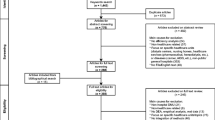Abstract
While home health care agencies (HHAs) play a vital role in the production of health, little research has been performed gauging their efficiency. Employing a robust approach to data envelopment analysis (DEA) we assessed overall, technical, and scale efficiency on a nationwide sample of HHAs. After deriving the three efficiency measures, we regressed these scores on a variety of environmental factors. We found that HHAs, on average, could proportionally reduce inputs by 28 % (overall efficiency), 23 % (technical efficiency) and 6 % (scale efficiency). For-profit ownership was positively associated with improvements in overall efficiency and technical efficiency and chain ownership was positively associated with global efficiency. There were also state-by-state variations on all the efficiency measures. As home health becomes an increasingly important player in the health care system, and its share of national health expenditures increases, it has become important to understand the cost structure of the industry and the potential for efficiencies. Therefore, further research is recommended as this sector continues to grow.
Similar content being viewed by others
Notes
We thank an anonymous referee for pointing this out.
References
Centers for Medicare & Medicaid Services (2015) Home health services. www.medicare.gov/coverage/home-health-services.html#1367. Accessed 1 Dec 2014
Centers for Medicare & Medicaid Services. National Health Expenditure Historical Data 1960–2012. Available via Centers for Medicare & Medicaid Services http://www.cms.gov/Research-Statistics-Data-and-Systems/Statistics-Trends-and-Reports/NationalHealthExpendData/NationalHealthAccountsHistorical.html. Accessed 1 Dec 2014
Medicare Payment Advisory Committe (MedPAC) (2014) A Data Book - Health Care Spending and the Medicare Program June 2014. http://www.medpac.gov/documents/publications/jun14databookentirereport.pdf?sfvrsn=1. Accessed 12 Nov 2014
Centers for Medicare & Medicaid SerVices (2012). National Health Expenditure Projections 2011–2021. http://www.cms.gov/Research-Statistics-Data-and-Systems/Statistics-Trends-and-Reports/NationalHealthExpendData/Downloads/Proj2011PDF.pdf. Accessed 26 July 2012
Centers for Disease Control and Prevention. National Home and Hospice Care Survey (NHHCS) 2007. Available via usa.gov http://www.cdc.gov/nchs/nhhcs/about_nhhcs.htm. Accessed 5 Dec 2014
Dudzinski CS, Erekson OH, Ziegert AL (1998) Estimating an hedonic translog cost function for the home health care industry. Appl Econ 30(9):1259–1267
Gonzales TI (1997) An empirical study of economies of scope in home healthcare. Health Serv Res 32(3):313–324
Hay JW, Mandes G (1984) Home health care cost-function analysis. Health Care Financ Rev 5(3):111–116
Kass DI (1987) Economies of scale and scope in the provision of home health services. J Health Econ 6(2):129–146
Nyman JA, Dowd BE (1991) Cost function analysis of medicare policy: are reimbursement limits for rural home health agencies sufficient? J Health Econ 10(3):313–327
Nyman JA, Svetlik MA (1989) Does the average cost of home health care vary with case mix? Public Health Rep 104(4):335–341
Mukamel DB, Fortinsky RH, White A, Harrington C, White LM, Ngo-Metzger Q (2014) The policy implications of the cost structure of home health agencies. Medicare Medicaid Res Rev 4(1):E1–E23
Ozcan Y (2014) Health care benchmarking and performance evaluation: an assessment using Data Envelopment Analysis (DEA). Springer, New York
Valdmanis V (1992) Sensitivity analysis for DEA models: an empirical example using public vs. NFP hospitals. J Publ Econ 48(2):185–205
Ozcan Y, Woge S, Mau LW (1998) Efficiency evaluation of skilled nursing facilities. J Med Syst 22(4):211–224
Rosko M, Chilingerian J, Zinn J, Aaronson W (1995) The effects of ownership, operating environment, and strategic choices on nursing home efficiency. Med Care 33(10):1001–1021
Ozcan Y, Cotter J (1994) An assessment of efficiency of area agencies on aging in Virginia through data envelopment analysis. Gerontologist 34(3):363–370
Ferrier G, Valdmanis V (2003) Exploring psychiatric hospital performance using data envelopment analysis and cluster analysis. J Econ Med 20(3):143–153
Simar L, Wilson PW (1998) Sensitivity analysis of efficiency scores: how to bootstrap in nonparametric frontier models. Manag Sci 44:49–61
Simar L, Wilson PW (2007) Estimation and inference in two-stage, semi-parametric models of production processes. J Econ 136:31–64
Politis DN, Romano JP (1994) large sample confidence regions based on subsamples under minimal assumptions. Ann Stat 22:2031–2050
Politis DN, Romano JP (1999) Subsampling. Springer, New York
Politis DN, Romano JP, Wolf M (2001) On the asymptotic theory of subsampling. Stat Sin 11:1105–1124
Bickel PJ, Sakov A (2008) On the choice of m in the m out of n bootstrap and confidence bounds for extrema. Stat Sin 18:967–985
Kneip A, Simar L, Wilson PW (2008) asymptotics and consistent bootstraps for dea estimators in non-parametric frontier models. Econ Theory 24:1663–1697
Kneip A, Simar L, Wilson PW (2011) a computationally efficient, consistent bootstrap for inference with non-parametric dea estimators. Comput Econ 38:483–515
Simar L, Wilson PW (2011) Inference by the m out of n bootstrap in nonparametric frontier models. J Prod Anal 36:33–53
Färe R, Grosskopf S, Lovell CAK (1994) Production frontiers. Cambridge University Press, Cambridge
Farrell M (1957) The measurement of productive efficiency. J R Stat Soc Ser A, General 120:253–281
Madigan EA, Fortinsky RH (2004) Interrater reliability of the outcomes and assessment information set: results from the field. Gerontologist 44(5):689–692
Tullai-McGuinness S, Madigan EA, Fortinsky RH (2009) Validity testing the Outcomes and Assessment Information Set (OASIS). Home Health Care Ser Q 28(1):45–57
Grosskopf SV, Valdmanis V (1987) Measuring hospital performance: a nonparametric approach. J Health Econ 6(2):89–107
Madigan E, Schott D, Matthews C (2001) Rehospitalization among home healthcare patients: results of a prospective study. Home Health Nurse 19(5):298–305
Mutter R, Valdmanis V, Rosko M (2010) High versus lower quality hospitals: a comparison of environmental characteristics and technical efficiency. Health Serv Outcome Res Method 10:134–153
Rosko M (1999) Impact of internal and external environmental pressures on hospital inefficiency,”. Health Care Mgt Sci 2:63–74
Rosko M (2001) Impact of HMO penetration and other environmental factors on hospital x-inefficiency. Med Care Res Rev 58(4):430–454
Kelly D, Amburgey TL (1991) Organizational inertia and momentum: a dynamic model of strategic change. Acad Manag J 34(3):591–612
Hollingsworth B (2003) Non-parametric and parametric applications measuring efficiency in health care. Health Care Manag Sci 6(4):203–218
Author information
Authors and Affiliations
Corresponding author
Rights and permissions
About this article
Cite this article
Valdmanis, V.G., Rosko, M.D., Leleu, H. et al. Assessing overall, technical, and scale efficiency among home health care agencies. Health Care Manag Sci 20, 265–275 (2017). https://doi.org/10.1007/s10729-015-9351-1
Received:
Accepted:
Published:
Issue Date:
DOI: https://doi.org/10.1007/s10729-015-9351-1




